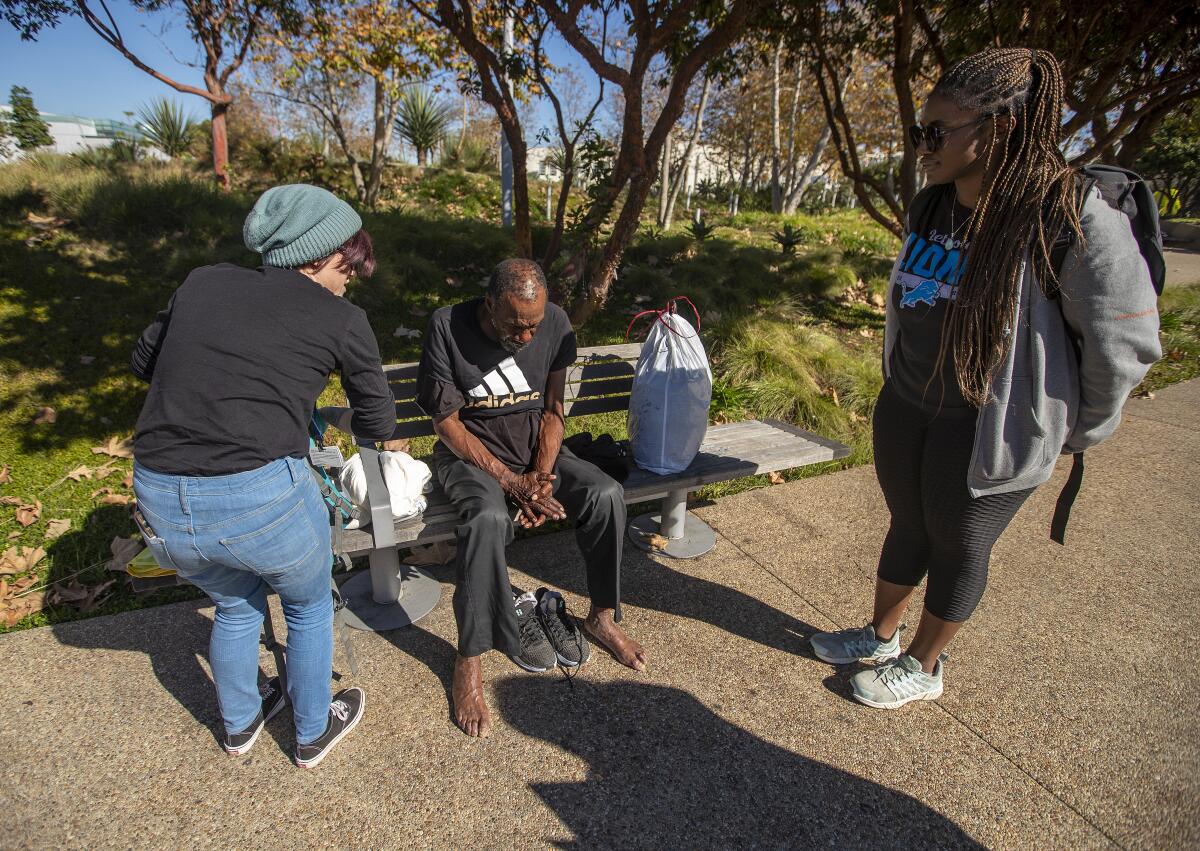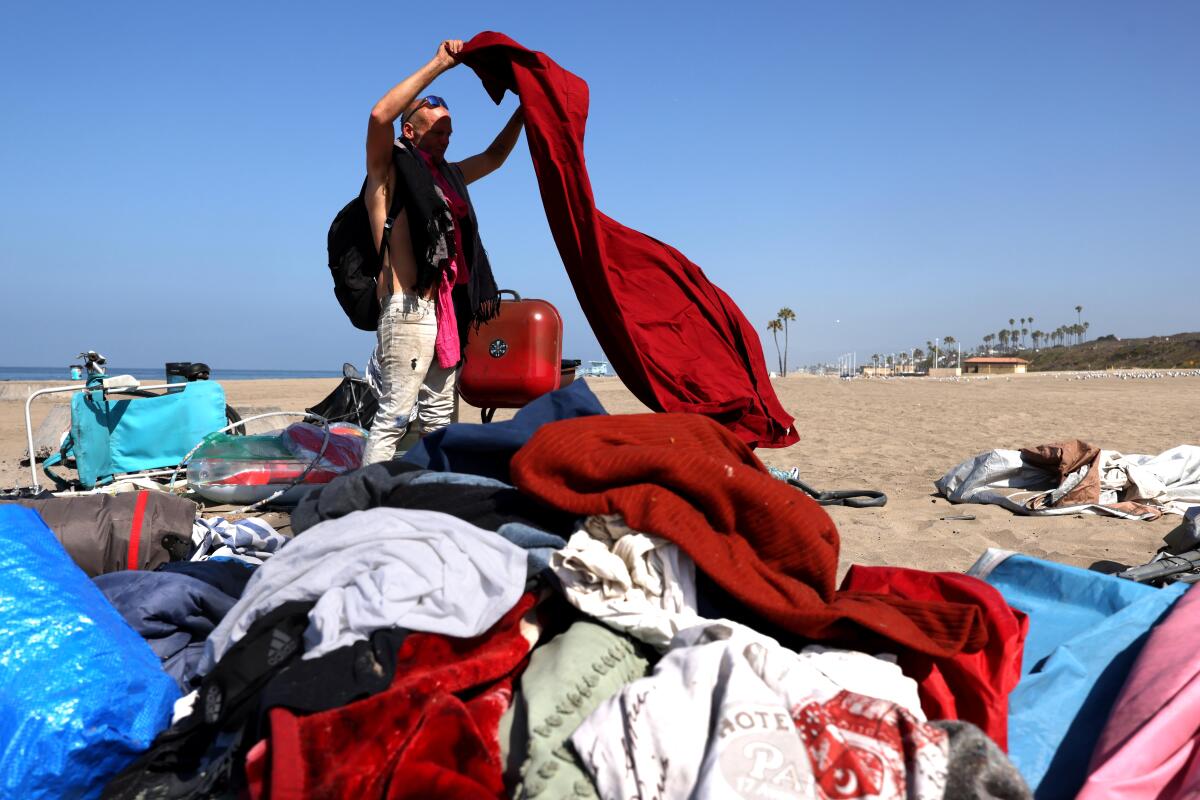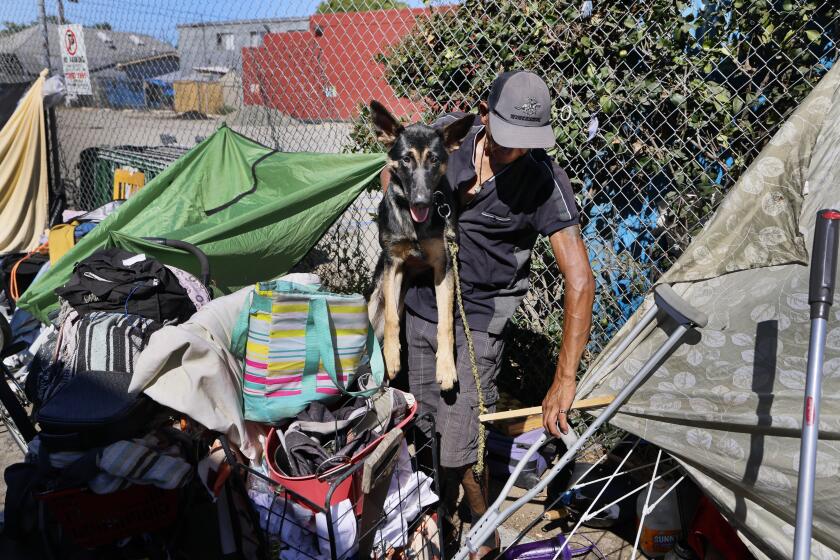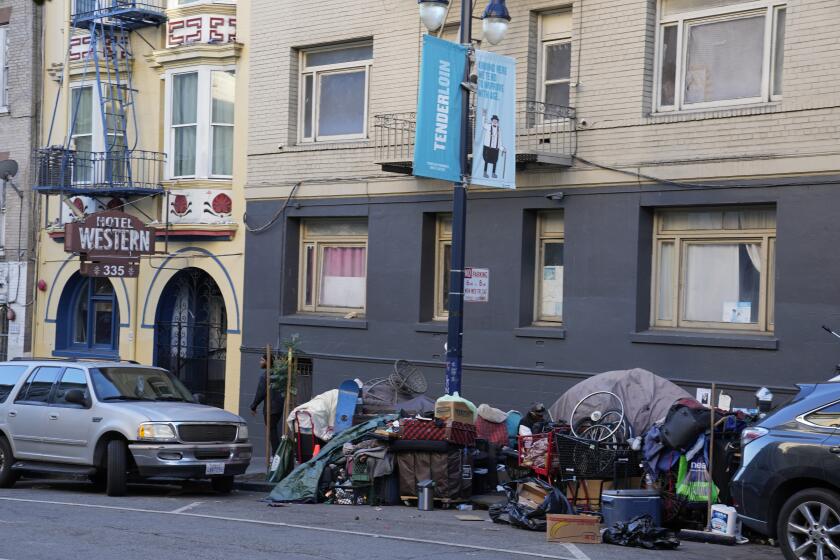Sleeping with a pillow or blanket outdoors can be a sign of illegal camping in Santa Monica

- Share via
A narrowly divided Santa Monica City Council voted this week to remove a section of its anti-camping ordinance that allowed people experiencing homelessness to use pillows, blankets and bedrolls while sleeping outdoors.
In a 4-3 vote, the council reversed a step taken in 2022 to comply with a federal appeals court ruling that declared it unconstitutional to bar people from “protect[ing] themselves from the elements when there is no shelter space available.” The Supreme Court overturned that ruling three months ago.
The council majority also directed administrative, housing and law enforcement staff to look at how other municipalities are addressing homeless encampments. The amended ordinance, which is expected to be formally adopted later this month, is slated to go into effect in mid-October.
Although Santa Monica does not prohibit sleeping on public property, it does prohibit camping. The amendment means that Santa Monica police officers will have more discretion about what constitutes camping on public property and therefore more leeway when issuing citations or making arrests.
Long Beach has begun enforcing its anti-camping laws. City officials say they are emphasizing compassion in the sweeps, but police say they won’t hesitate to issue fines and citations if needed.
The amendments will also provide city prosecutors more evidence to use in criminal cases.
Critics say the changes are cruel and will bring added hardship to an already vulnerable population that may decide to discard pillows and blankets to avoid violating the ordinance.

Proponents say the change will give police an added tool to engage homeless people and build a rapport in an effort to encourage them to get off the streets.
Police Chief Ramon Batista told council members before Tuesday’s vote that the amendments would not change how officers enforce anti-camping laws and interact with the city’s homeless population.
“Sleeping in public spaces is not what we are regulating,” he said. “We’re regulating encampments in public space, and we’ve been successful because we follow the guidelines on how to approach these individuals in cases where they’re beginning to build a camp.”
Jenna Grigsby, chief of the Criminal Division of the city attorney’s office, said officers have been trained to look at the totality of circumstances to show that someone is camping, not just sleeping, on a public space.
“I’ve been doing this to the point that I understand what camping means, and it’s not purely one object” in the homeless person’s possession, she said. “You have to be able to show that this person has taken over public space for the purpose of a living accommodation.”
City officials say in the case of the amended anti-camping ordinance, a blanket and a pillow would not be enough to prove that someone is camping on public property.
Batista, however, acknowledged that the items would give officers a reason to detain homeless people.
Councilwoman Gleam Davis disagreed with that tactic and suggested that officers approach people who are willing to talk to them. Batista said officers do that as well.
The justices parse the rights and humanity of homeless people in a potentially far-reaching case, plus more from Opinion.
Councilwoman Caroline Torosis raised concerns that the enforcement would mostly affect Black and Latino people, who make up a large portion of the city’s homeless population.
“The same fines and citations can actually become a barrier to getting Section 8 [housing aid], to getting permanent housing, to getting a job,” Torosis said. “We need to help people with rehabilitative measures, not punitive measures.”
Davis, Torosis and Councilman Jesse Zwick voted against the changes, while Mayor Phil Brock, Mayor Pro Tem Lana Negrete and Councilmembers Oscar de la Torre and Christine Parra cast votes in favor.
Brock, who is running for reelection, has long maintained that compassion for homeless people sometimes turns into neglect. He said he supported the ordinance in an effort to push people to get indoors.
“How are we accepting people living in our streets, living in alleys or living in carports for days, weeks and months,” he said. “I don’t care whether they have a pillow, a backpack, a tent or a cooking stove, they’re living in our streets and they’re being neglected.”
The changes to Santa Monica’s ordinance comes as other California cities are cracking down on homeless encampments in response to the June Supreme Court ruling in Grant Pass vs. Johnson. In a 6-3 decision, the justices held that laws penalizing homeless people for sleeping or pitching tents in public spaces do not constitute cruel and unusual punishment.
The landmark decision ended years of protections for people experiencing homelessness and paved the way for California cities to start clearing encampments from parks, sidewalks and other areas even when they lack sufficient shelter beds.
Santa Monica, known for its progressive stances on many issues, now joins other towns that have taken a more aggressive approach when it comes to encampments they consider problematic.
California officials announced a settlement with Elk Grove that requires the city to identify sites for low-income housing and pay the state’s legal fees.
On the same night that the city approved its controversial amendments, the Berkeley City Council adopted new rules that would allow city workers to clear homeless encampments without offering shelter first.
Berkeley’s rules, however, apply just to encampments that are a fire hazard and pose a health risk or impede public or utility operations.
Last month, Newport Beach beefed up its anti-camping laws to make it illegal to store belongings on public property and expanded the definition of camping to include people sleeping in vehicles. City leaders also assigned more officers to handle calls related to homeless people.
That same month, the city of Long Beach began clearing encampments deemed to pose a threat to public health and safety or where unhoused people have been resistant to services. The city said while it would aim to get people into shelters, it would also give police the discretion to issue citations and possibly make arrests.

Santa Monica has long dealt with homelessness, but a recent wave of crimes on the city’s promenade and beaches where tourists gather have raised concerns about public safety.
“I look at our residents who are … frustrated as hell because there are [homeless] people in their alleys and on their streets,” Brock said. “And for whatever reason, whether it’s unjustified or not, they’re fearful of their own city, they’re fearful of a place they came to because we have the best climate for them, we have palm trees, a beautiful ocean and great parks and now they’re afraid to use them.”
“I think we have to have that part of the discussion,” he said.
The latest annual count found an estimated 774 people experiencing homelessness in Santa Monica in January, a 6% drop from 826 in 2023, according to the city’s recent homeless count. At least 62% of that population lived outdoors.
City officials said programs preventing homelessness, combined with enforcement of its anti-camping laws, have kept encampments from cropping up to the extent seen in other cities.
The city also has shelter beds to move people off the street, although the city is 100 beds short of where they need to be to fully accommodate the unsheltered population.
Measure ULA has faced numerous challenges since it was approved, and its fate is uncertain, but the city is moving forward to develop programs with the tax money.
Tuesday night’s amendments stem from a July City Council meeting in which Negrete and de la Torre asked the city manager and city attorney’s office to “evaluate and provide options to amend the city’s municipal code” in light of the Supreme Court decision.
In supporting the changes to the ordinance, Brock and Negrete at times sketched out a homeless population made up of mostly drug addicts and mentally ill people.
“I think we’re trying to paint a picture that women and children and people with babies are shivering outside in the cold and that’s our homeless population, I know that exists somewhere,” Negrete said. “But I think what we are seeing and what we are responding to is the fact that we have a mental health crisis and a substance abuse crisis, and the majority of the people out on our streets are experiencing those things … ”
The pair also implied that many of the homeless people are not from the city, despite numerous research studies showing that the vast majority of people experiencing homelessness have ties to the places they’re in.
At some point, Brock accused San Francisco and Vancouver of sending homeless people to Southern California, where they then end up in Santa Monica.
“I’m getting reports from LAX that people are getting off those planes, they’re homeless and they’re asking where’s Venice, where’s Santa Monica,” he said.
U.S. cities have relocation programs to help homeless people move to places where they have family members who will care for them.
Both Humboldt County and San Francisco have programs to relocate homeless people to other cities and states where they have ties. But Humboldt leaders contend San Francisco’s approach is just shifting the problem across county lines.
Zwick questioned whether the changes to the ordinance were necessary.
“I hear this is not really going to change anything, then I also hear that it is really important that we change,” he said. “Either it’s going to do something really different, which is worrisome to me because I think we do things pretty well here, or it’s not really going to do anything, and then we’re just all enacting a bunch of theater up here to act like we’re doing something.”
Negrete explained that the purpose was to remove language added to the ordinance two years ago and to make it less easy for folks to sleep outdoors.
“We don’t want to create an environment where people can create the ability to sleep outside,” she said. “We have services and service providers, and we need more for sure, but why not create an environment where we say we want to be able to engage and encourage you to get those services?”
More to Read
Sign up for Essential California
The most important California stories and recommendations in your inbox every morning.
You may occasionally receive promotional content from the Los Angeles Times.



















